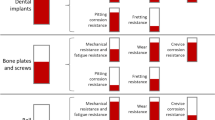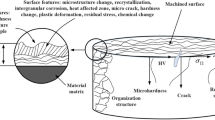Abstract
In total knee replacement surgery, the excessive cutting force generated when cutting bone tissue can cause bone cracks and stress concentration, leading to mechanical damage of bone tissue and surrounding tissues and affecting the fit precision of the joint. Reasonable micro-texturing can improve the tool’s surface wettability and cutting performance, reduce the appearance of the above problems, and thus improve the quality of bone cutting. For this reason, this study assessed the surface wettability of micro-texture on a cutting tool surface using a contact angle measurement meter. A bone milling test platform was established to explore the effects of micro-texture parameters on bone milling forces. Scanning electron microscopy was used to observe the morphology of the milled bone surface. Strains on the bone surface after loading were observed by two-dimensional digital image correlation to investigate the effect of micro-texture parameters on bone surface damage. The results proved that micro-textured bone milling tools with stronger hydrophilicity reduced the bone milling force, thus reducing the bone surface’s damage and improving bone milling quality.










Similar content being viewed by others
References
Ong FR, Bouazza-Marouf K (1999) The detection of drill bit break-through for the enhancement of safety in mechatronic assisted orthopaedic drilling. Mechatronics 9(6):565–588. https://doi.org/10.1016/S0957-4158(99)00019-7
Bai W, Shu LM, Sun RL, Xu JF, Silberschmidt VV, Sugita N (2020) Mechanism of material removal in orthogonal cutting of cortical bone. J Mech Behav Biomed Mater 104:103618. https://doi.org/10.1016/j.jmbbm.2020.103618
Raghavan A, Wright JM, Wright CH, Sajatovic M, Miller J (2018) Effect of dural substitute and technique on cranioplasty operative metrics: a systematic literature review. World Neurosurg 119:282–289. https://doi.org/10.1016/j.wneu.2018.08.024
Sugita N, Osa T, Aoki R, Mitsuishi M (2009) A new cutting method for bone based on its crack propagation characteristics. CIRP Ann Manuf Technol 58(1):113–118. https://doi.org/10.1016/j.cirp.2009.03.057
Liao Z, Axinte DA, Gao D (2017) A novel cutting tool design to avoid surface damage in bone machining. Int J Mach Tools Manuf 116:52–59. https://doi.org/10.1016/j.ijmachtools.2017.01.003
Yao Q, Luo M, Zhang DH, Wu BH (2018) Identification of cutting force coefficients in machining process considering cutter vibration. Mech Syst Signal Process 103:39–59. https://doi.org/10.1016/j.ymssp.2017.09.038
Liao ZR, Axinte D, Gao D (2019) On modelling of cutting force and temperature in bone milling. J Mater Process Technol 266:627–638. https://doi.org/10.1016/j.jmatprotec.2018.11.039
Agarwal R, Gupta V, Singh J, Jain V (2022) Prediction of surface roughness and cutting force induced during rotary ultrasonic bone drilling via statistical and machine learning algorithms. Proc Inst Mech Eng Part C-J Mechan Eng Sci 236(23):11123–11135. https://doi.org/10.1177/0954406222111040
Zawadzki P, Talar R, Patalas A, Legutko S (2022) Influence of machining parameters on cutting and chip-formation process during cortical bone orthogonal machining. Materials 15(18):6414. https://doi.org/10.3390/ma15186414
Jamil M, Khan E, Mia M, Iqbal A, Gupta MK, Sen B (2019) Evaluating the effect of micro-lubrication in orthopedic drilling. Proc Inst Mech Eng Part H-J Eng Med 233(10):1024–1041. https://doi.org/10.1177/0954411919865389
Ranjan P, Hiremath SS (2019) Role of textured tool in improving machining performance: a review. J Manuf Process 43:47–73. https://doi.org/10.1016/j.jmapro.2019.04.011
Li QH, Pan C, Jiao YX, Hu KX (2019) Investigation on cutting performance of micro-textured cutting tools. Micromachines 10(6):352. https://doi.org/10.3390/mi10060352
Koshy P, Tovey J (2011) Performance of electrical discharge textured cutting tools. CIRP Ann Manuf Technol 60(1):153–156. https://doi.org/10.1016/j.cirp.2011.03.104
Wang QW, Yang Y, Yao P, Zhang ZY, Yu SM, Zhu HT, Huang CZ (2021) Friction and cutting characteristics of micro-textured diamond tools fabricated with femtosecond laser. Tribol Int 154. https://doi.org/10.1016/j.triboint.2020.106720
Parida AK, Rao PV, Ghosh S (2020) Performance of textured tool in turning of Ti-6Al-4V alloy: numerical analysis and experimental validation. J Braz Soc Mech Sci Eng 42(5). https://doi.org/10.1007/s40430-020-02333-2
Rajbongshi SK, Sarma DK (2019) Performance parameters studies in machining of AISI D2 steel with dot-textured, groove-textured & non-textured cutting tool at the flank face. Int J Refract Met Hard Mater 83. https://doi.org/10.1016/j.ijrmhm.2019.104970
Sugita N, Ishii K, Sui JB, Terashima M (2014) Multi-grooved cutting tool to reduce cutting force and temperature during bone machining. CIRP Ann Manuf Technol 63(1):101–104. https://doi.org/10.1016/j.cirp.2014.03.069
Guimaraes B, Fernandes CM, Figueiredo D, Carvalho O, Silva FS, Miranda G (2020) Effect of laser surface texturing on the wettability of WC-Co cutting tools. Int J Adv Manuf Technol 111(7–8):1991–1999. https://doi.org/10.1007/s00170-020-06155-3
Yang QB, Zhou W, Wang L, Ren XP, Wang YT, Lou DY, Chen L, Cheng J, Zheng Z, Liu D (2021) Wettability control on YW2 cemented carbide surface by femtosecond laser irradiation. Phys Status Solidi A-Appl Mater Sci 218(9). https://doi.org/10.1002/pssa.202000709
Ge DL, Deng JX, Duan R, Li XM, Liu YY, Yue HZ (2019) Effect of surface wettability on tribological properties of Al2O3/TiC ceramic under wet lubrication. Ceram Int 45(18):24554–24563. https://doi.org/10.1016/j.ceramint.2019.08.184
Chen YH, Wang J, An QL (2020) Mechanisms and predictive force models for machining with rake face textured cutting tools under orthogonal cutting conditions. Int J Mech Sci 195:106246. https://doi.org/10.1016/j.ijmecsci.2020.106246
Hao XQ, Cui W, Li L, Li HL, Khan AM, He N (2018) Cutting performance of textured polycrystalline diamond tools with composite lyophilic/lyophobic wettabilities. J Mater Process Technol 260:1–8. https://doi.org/10.1016/j.jmatprotec.2018.04.049
Duan Z, Chen L, Li B (2022) Effect of micro-textured morphology with different wettabilities on tool cutting performance. Int J Adv Manuf Technol 123:1745–1754. https://doi.org/10.1007/s00170-022-10284-2
Pang K, Wang D (2020) Study on the performances of the drilling process of nickel-based superalloy Iconel 718 with differently micro-textured drilling tools. Int J Mech Sci 180:105658. https://doi.org/10.1016/j.ijmecsci.2020.105658
Mazloompour M, Ansari N, Hemmatinejad N (2007) Wetting behaviour of raw and water-repellent cotton fabrics using wetting kinetic measurements. Indian J Fibre Text Res 32(1):93–98. http://nopr.niscpr.res.in/handle/123456789/299
Bai W, Shu LM, Sun RL, Xu JF, Silberschmidt VV, Sugita N (2020) Mechanism of material removal in orthogonal cutting of cortical bone. J Mech Behav Biomed Mater 104. https://doi.org/10.1016/j.jmbbm.2020.103618
Tahmasbi V, Qasemi M, Ghasemi R, Gholami R (2022) Experimental study and sensitivity analysis of force behavior in cortical bone milling. Med Eng Phys 105. https://doi.org/10.1016/j.medengphy.2022.103821
Sciacchitano A (2019) Uncertainty quantification in particle image velocimetry. Measurement Science and Technology 30(9). https://doi.org/10.1088/1361-6501/ab1db8
Pan B, Qian KM, Xie HM, Asundi A (2009) Two-dimensional digital image correlation for in-plane displacement and strain measurement: a review. Measurement Science and Technology 20(6). https://doi.org/10.1088/0957-0233/20/6/062001
Guo HY, Li B, Feng XQ (2016) Stability of Cassie-Baxter wetting states on microstructured surfaces. Phys Rev E 94(4). https://doi.org/10.1103/PhysRevE.94.042801
Liu WL, Ni HJ, Chen HL, Wang P (2019) Numerical simulation and experimental investigation on tribo-logical performance of micro-dimples textured surface under hydrodynamic lubrication. Int J Mech Sci 163:105095–105095. https://doi.org/10.1016/j.ijmecsci.2019.105095
Liao ZR, Axinte DA (2016) On chip formation mechanism in orthogonal cutting of bone. Int J Mach Tools Manuf 102:41–55. https://doi.org/10.1016/j.ijmachtools.2015.12.004
Barak Y, Srivastava A, Osovski S (2019) Correlating fracture toughness and fracture surface roughness via correlation length scale. Int J Fract 219(1):19–30. https://doi.org/10.1007/s10704-019-00377-7
Funding
This research was supported by the National key research and development plan project (No.2022YFE0112500), China; 2023 Tianjin Bone Implant Interface Functionalization and Personalization Research Enterprise Key Laboratory Open Fund Project (No. SY-04–202301),China; Tianjin University of technology 2022 University-level Postgraduate Research and Innovation Practice Project (NO.YJ2207, YJ2210), China; and 2022 Tianjin Postgraduate Research Innovation Project (Service Industry Special)(NO.2022SKYZ144, 2022SKYZ147), China.
Author information
Authors and Affiliations
Contributions
All authors contributed to the study conception and design. Material preparation, methodology, cutting experiments, writing—original draft, data collection, and analysis were performed by Jie Zhong, Lingrui He. Experimental method guidance and writing—review and editing were performed by Yahui Hu, Chunqiu Zhang, and Weihua Fu. Supervision, funding acquisition, and writing—review and editing were performed by Shuhong Liu. All authors read and approved the final manuscript.
Corresponding author
Ethics declarations
Ethics approval
This paper does not include any research conducted by any author with humans or animals as participants.
Competing interests
The authors declare no competing interests.
Additional information
Publisher's Note
Springer Nature remains neutral with regard to jurisdictional claims in published maps and institutional affiliations.
Rights and permissions
Springer Nature or its licensor (e.g. a society or other partner) holds exclusive rights to this article under a publishing agreement with the author(s) or other rightsholder(s); author self-archiving of the accepted manuscript version of this article is solely governed by the terms of such publishing agreement and applicable law.
About this article
Cite this article
Hu, Y., Zhong, J., He, L. et al. Study the regularity of micro-texture parameters of bone milling tool surface for wettability improved and bone surface damage reduction. Int J Adv Manuf Technol 131, 5343–5352 (2024). https://doi.org/10.1007/s00170-024-13098-6
Received:
Accepted:
Published:
Issue Date:
DOI: https://doi.org/10.1007/s00170-024-13098-6




